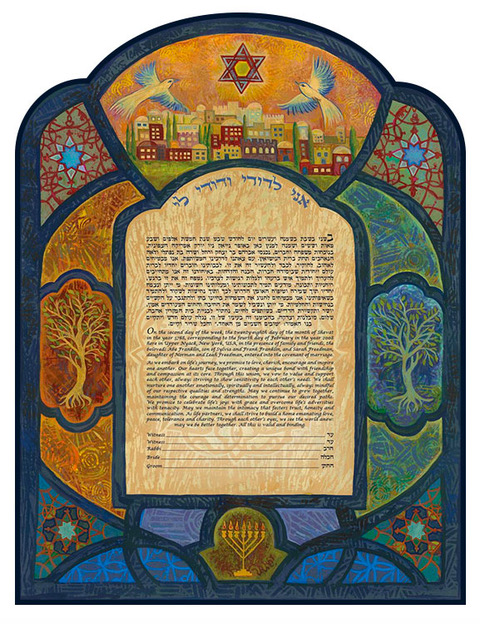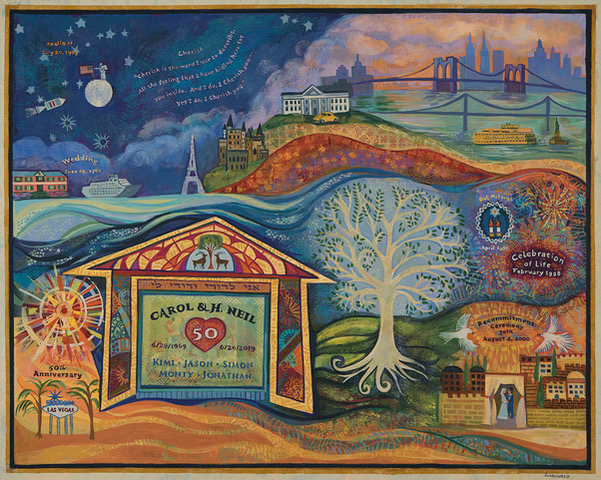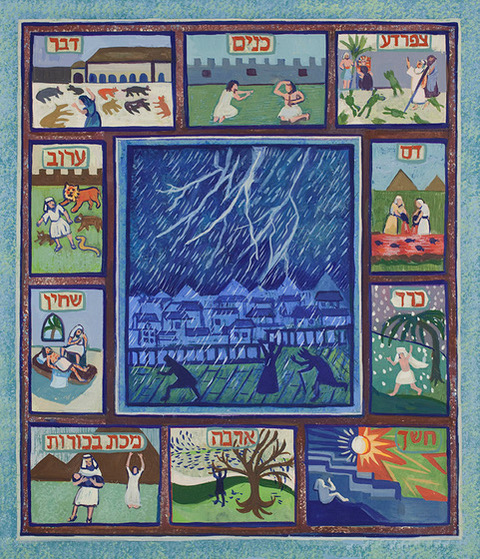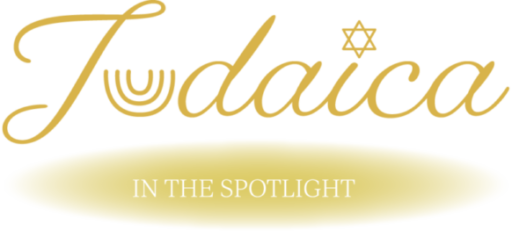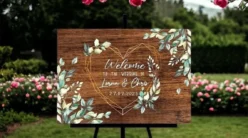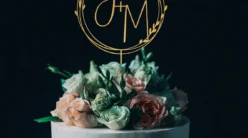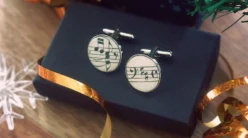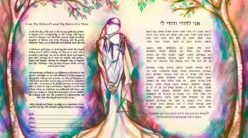
Lori Loebelsohn is a professional artist who specializes in creating personalized Ketubot and other Judaic art. She enjoys working collaboratively with her clients to achieve unique painterly designs that blend ritual with important personal symbols. These works include a personalized Haggadah, home blessings, and many unique pieces for major life cycle events such as weddings, b’nai mitzvot, births, and milestone birthdays and anniversaries. Lori received her BFA from the Cooper Union School of Art in 1982. She received an MS from Hunter College in 1990. In addition to creating Judaica art, Lori works as an illustrator. Her work has been published by Harper Collins, Cambridge University Press, Providence Publishing, and Eakins Press. In 2018, Temple Ner Tamid of Bloomfield, NJ, commissioned an original work of art as the congregations’ gift to the Rabbi on the occasion of his retirement. Lori has designed the artwork for Cantor Meredith Greenberg’s debut CD, “P’ticha,” 2012, and CD covers for Susan Borofsky’s “Songs of Jewish Renewal,” 2005, and “From Schtetls to Standards,” 2005. Lori has also created intricate and highly decorative posters and illustrations for a variety of organizations, including BlueWave NJ the Ashenfelter 8K Run, and The Village Trip. Lori aims to create paintings that pay homage to the Judaic work of the past while incorporating her own unique imagery, color and themes.
Tell us a little bit about yourself and your background.
I grew up in Brighton Beach, Brooklyn. My father was a New York City police officer and my mother was a fashion illustrator. My identical twin sister is a decorative painter and a fine artist. I was exposed to museums, art classes, and art materials from a very young age. I have always loved to create things with my hands, and I cannot remember a time when I wasn’t making something. Painting and drawing were always the constants in my life through grade school and High School. So, it was not surprising when I chose to major in art. I studied first at Parsons School of Design, and then transferred to the Cooper Union School of Art, where I received my BFA. After college, I taught art to students with learning disabilities and received a Masters in education from Hunter College. I have simultaneously pursued a career as a learning specialist and as an artist. I live in New Jersey with my husband. I have a daughter and a son. When I am not painting or tutoring, I enjoy cycling, tennis, travel and spending time with my family.
What inspired you to become an artist?
I was fortunate to have had wonderful and encouraging art teachers not only in art school, but also in public school. They exposed me to the Old Masters, Modern art and the importance of art in society. I watched my mother work painstakingly in her studio creating beautiful fashion illustrations for Vogue and Bergdorf Goodman. I could feel the love of art in my blood. The idea of creating something brand new that has never existed before, especially when so many things are now mass produced, has always been extremely satisfying.
What is your specialty?
Since 2005, I have focused on creating symbolic portraits that I call, “Life Cycle Portraits”. These paintings include stories, memories and images that are symbolic representations of a person’s life or an important life cycle event. My work has been greatly influenced by early American quilts, medieval Ketubot, stained glass and illuminated manuscripts. This body of work has evolved to include both religious and secular themes, as well as personal symbols. I have been commissioned to create many paintings for life cycle events, such as births, b’nai mitzvot, graduations, weddings, anniversaries and even a 100th birthday celebration. Perhaps the most significant celebratory life cycle event is a marriage. Throughout history, Jews have been forced to flee their homes because of persecution and in search of safety, often bringing only what could carry on their backs. The Ketubah, one of the most cherished possessions, almost always made the journey. I was deeply moved and inspired to see a show at the Jewish Museum in New York several years ago that featured these beautiful works of art from around the world. Although often ripped, tattered and faded, many survived their tumultuous journeys. The art of the Ketubah is such a rich art form and an inspiration to me. I love that the ritual of having a beautifully illustrated Ketubah as part of the wedding celebration has seen a resurgence in the 21st century. This old art form has been reinterpreted by artists today to reflect our values and times. Beautiful modern artworks with new inclusive texts continue to evolve and are constantly being reinterpreted. I am honored that my work is part of this wonderful tradition and I wonder how the art of the Ketubah will evolve in future generations.
How and where do you work?
I live and work in a historic colonial house in New Jersey. My preferred medium is gouache on Strathmore paper. I love the rich, luminous colors and the versatility of gouache. I like to experiment with new ways of using gouache in order to achieve different techniques. These include stencilling, sanding, and sponging. To maintain the brilliance of the gouache paint, I premix my palette. Before I put brush to paper, I think a lot about the “family” of colors and the kind of mood I want to create, with the main goal of maintaining a sense of color harmony in the overall painting. My palette is determined by the subject matter and the feeling that I want to achieve. The work of Joseph Albers has greatly influenced my understanding of color theory. I also focus a lot on preliminary and more finished sketches. I tend to work systematically. Although much is planned out, my aim is to achieve a feeling of spontaneity in the painting.
What is the most indispensable item in your studio?
I love using high quality art materials. My paints, brushes and paper are my favorite things in my studio. I also must admit that I have begun to use technology as a tool for some aspects of my work. But I will always prefer the kinaesthetic feeling of being able to create something by hand to realize the vision that I have in my head.
Where do you take your inspiration? Are you pursuing any themes?
I am inspired by other artists, nature and archetypal themes in mythology and religion. These archetypes often refer to themes in nature and life cycle events that helped earlier civilizations make sense of their world. They include birth, coming of age, marriage and death, as well as natural phenomena like the sun, moon, stars and the seasons. Although I was familiar with archetypal imagery in Western (frequently Christian-themed) art, I had not previously considered applying these archetypal themes to Judaic art. I fell into the world of Judaic art by chance. I had just created a painting addressing slavery on a late 18th century Brooklyn farm for the Lefferts Homestead Historic House Museum. In order to achieve the look of folk art, I began experimenting with gouache. Soon after, a client asked me to paint a quilt-inspired painting and to include personal imagery in the squares of the painting. I enjoyed doing this painting and soon after, I began receiving commissions for all types of paintings about important life-cycle events. One of these was a painting for a bat mitzvah that combined the girl’s Parshah with personal images. The stories I heard from my clients were funny, sad, sentimental and meaningful, and they often included secret symbols and stories. I have developed a process for creating these pieces and the first step is always to have an in-depth interview with the client and on-going communication throughout the entire process. I’ve learned that every person has an amazing story to tell and it is my job to take their words and translate them into paintings. I’ve always enjoyed the collaborative nature of this work and I’ve enjoyed getting to know people from all over the world.
What projects are you currently working on?
I am usually working on multiple paintings. I just finished an interfaith baby naming painting for a couple for whom I had created a Ketubah several years earlier, and a print for a lesbian couple’s 10th anniversary. I am about to commence work on a 40th anniversary gift; a personalized bicycle-themed Ketubah for a couple that met and fell in love on bicycle rides; and a Celtic love poem for a recently married couple. As you can see, my work is not exclusively Judaic. My work is inclusive and I enjoy incorporating symbols from other religions and cultures. In addition to bespoke pieces, I am also developing several new original Ketubah designs.
What is your favourite item in your current collection?
I recently finished a painting for a client who surprised his wife with it at their 50th wedding anniversary party. This was probably the most detailed painting I have ever done. It is a life story map that features significant moments and events during their marriage. Although the painting is complex, I aimed to keep the composition flowing by preparing several preliminary sketches until I achieved an overall harmony in the design. The client’s wife was thrilled to receive such a personal and unique gift. For me, it was a touching and wonderful experience.
How do you know when a piece is finished?
Although my work tends to be very intricate and detailed, my goal is to achieve a feel that the colors and composition are spontaneous. Unlike oil, gouache becomes muddy when overworked and loses the luminosity that makes it so special. It takes a lot of tweaking and patience to achieve a happy balance. I like to leave the painting alone for a couple of days and then look at it from time to time before I call it done.
Do you do bespoke work?
Yes, I have done many one-of-a kind commissions for a variety of clients. I am honored that my work is being used as part of many life-cycle celebrations. Long after the celebration is over, my painting remains as a reminder of that special time. I have also created a variety of work for political and non-profit organizations and have even designed several bike jerseys. In between, I love experimenting with new ideas that are not for commissioned work.
What was the first artwork you ever sold?
In High School, I won a poster contest that came with what seemed like an exorbitant amount of money at the time for a high school student. I have always been an avid cyclist, but until then, I had never owned a new bicycle and I had always wanted one. With the prize money, I bought my very first brand new turquoise Fuji bicycle.
Which project have you enjoyed working on the most so far?
I was introduced to a gentleman who had recently lost his wife. He loved Passover and had always led his family’s Passover Seder. The general theme of a Seder is universal, yet he loved to embellish his Seder with personal traditions that had evolved over the course of his lifetime. As a tribute to his wife, he felt compelled to create his own family Haggadah that he would self-publish. He asked me to create the paintings for the Haggadah, fourteen in all.
During the course of our work together, my client’s health declined. Never before had I felt such urgency to complete artwork. This project, in which he had completely invested himself, gave him a purpose to stay alive. His ideas about what was important for this Haggadah were personal and very meaningful. The graphic design team and I raced to finish it. And we did. The final version of the Haggadah was completed and shared with my client. He approved the paintings. Sadly, but poetically, the next day he died peacefully in his sleep.
It was unbelievably sad that he did not live to celebrate Passover with his brand new, family Haggadah, but he left his family a most precious gift, a legacy for them to continue his Passover tradition for many years to come. The Haggadah, a physical reminder of him and his ideas and traditions, was a uniquely special project.
What do you want to achieve with your work and what are your wishes for the future?
I am thrilled to have my artwork play a role in so many joyous celebrations. My wish is that when people look at their painting through the years it brings back the feeling they had of that happy occasion. I am glad that my work is accessible to so many people. Also, I enjoy integrating seemingly disparate influences like stained glass and illuminated manuscripts into a painting and still have the painting feel whole. I plan to continue working in this way, but I hope to continue to evolve by experimenting with new techniques and materials in the future.
Where can we find your work?
My work can be found in the following places:
My main website is: www.loriloebelsohn.com
Ketubah.com, Toronto, Canada- https://www.ketubah.com/
CBL Fine Art in West Orange, New Jersey: http://www.cblfineart.com/shop/
https://www.instagram.com/lloebelsohn/
https://www.pinterest.com/lloebelsohn/
